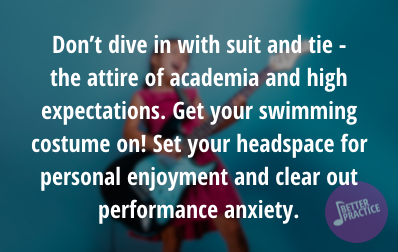
An Interview with Lyndel Kennedy of InnerMusician
Many teachers are interested in teaching improv and want to find ways to incorporate it into their curriculum but feel they don’t know enough about the topic to teach it. So – we sought an expert in the topic: Lyndel Kennedy, creator of InnerMusician, a program designed to make teaching improv fun and easy for both the teacher and student! And, she has great news: you don’t have to be a ‘master’ of improv to teach it! Anyone can incorporate improv into their curriculum with the right mindset.
See how teachers with no experience teaching improv can get started, what steps to take for your students, and how to conquer your fears of letting go!
1. Why is it important for students to be exposed to improvisation?

It provides an opportunity for self expression. All judgement aside,
this is so needed in a society where our primary form of self
expression lives in short-hand social media posts.
It’s the precursor to composition, often forging new musical styles.
The future of music depends on this creative infusion.
It assists in the transformation from head players to heart players, empowering students to explore their own musical personality, their
inner musician, their musical DNA.
This encourages individuality which fosters acceptance and inclusion
on a global scale.
It develops spontaneous problem solvers who can use the tools at
hand and think outside the box. These are the thinkers we need
moving into an increasingly complex future.
2. I know a lot of teachers, mostly classically trained, who want to but are unsure about how to dive into the world of improv. What are your thoughts on how to get started?

So how do you dive in? First, get your swimming costume on! Don’t
dive in with suit and tie – the attire of academia and high expectations. Set your headspace for ‘personal enjoyment’ and clear
out performance anxiety. I get that this is easier said than done,
especially perhaps for those of us who are classically trained.
Improv is something you first learn for yourself, putting aside the
judgement of others. Trust your previous training, your playing expertise – and then free fall into that dive. It’s the essence of improv! Allow yourself permission to explore and be adventurous. Many musicians experience a deeper acceptance of
themselves, and even live a little lighter in the experience!
TIP: One of the easiest ways to experience immediate improv satisfaction
is to play only on the black keys, using the sustain pedal to create
atmosphere. Moonlight Sonata takes on a whole new persona in the pentatonic
blackness! It works so well because you can’t actually play a wrong note. EVER! It
provides a valuable starting point for getting your mind in the
right space.
3. What’s your outline/basic path for teaching improv?
Before we play a single note we listen to a recorded piece (this
could be orchestral rather than just piano). Then I have the
students tell me how the music makes them feel. Once we have an
emotional place holder, we create an improvisation that expresses
that mood. This prevents us from always gravitating to our
favourite styles and becoming bored.
My first project is always the pentatonic black note improvisation.
I introduce simple musical patterns (motifs), encouraging students
to explore the motif across the entire piano, varying their
interpretation everyday. My students learn the basics of chord
building very early on and this establishes the basis for exploring
progressive harmonic improvisations. Eventually my students
transform their improvisations into compositions and this is when my
teaching gets very exciting!
4. Does this path differ if you’re teaching a student totally new to music vs. a more experienced music student who has never improvised?
All of my students (beginners or not) use the Play a Story program (by InnerMusician).
My 4-7 year olds learn improvisation exclusively for up to 12
months. They learn so much in this time and fall in love with
playing, which makes further learning a breeze.
More experienced students also learn improvisation using Play a
Story alongside my regular curriculum. They follow the same path as
my beginners but each student improvises to his or her own
imagination and ability. That’s the beauty of teaching improv. It
follows its own journey, to be celebrated no matter where a student
is on the learning continuum. I see it like landscaping a cottage
garden. It isn’t clipped and pruned, but rather it’s given the
freedom to take on its own beauty as it grows at its own rate.
5. What do you find is a common challenge for students learning improv and how do you/they overcome it?

I want to say firstly that many challenges are common to both
teachers and students. It’s helpful to know why these might be
occurring in order to understand how to get past them. Here are a
handful of challenges that I have come across with my own students
and which seem to also pop up when I speak to other teachers.
- Initial apprehension, if improvisation is not
familiar to them. Simply put, any new skill can create a level of
anxiety, especially one that is not quite as black and white as
playing predetermined notes and rhythms like we would in a
repertoire or rote piece. Students need to trust the process of
growth and be willing to just jump in. A sense of familiarity will
soon develop and they’ll find their own comfort level, allowing the
time needed to grow and mature through the experience of doing. The
teacher’s role is to inspire confidence in the student with projects
that give a winner’s outcome every time. With improvisation it’s all
about the journey, the process of discovery, not the destination. It
can be a thrilling and truly liberating journey, the like which
can’t easily be found elsewhere.
- Often students feel that only a certain ‘quality’ of artist can be inducted into the ‘Improv Club’. They might feel that they are just
not good enough. A lot of judgmental baggage comes with the arts. It
is perpetuated, in part, through assessment and performance
expectations that are to be required, mostly through education from
a very young age (and getting younger and younger). No matter
what your background, I encourage you to let go of judgement (placed
either on yourself as a teacher or on your students), and relish the
opportunity to just play in the moment. As one my 8 year old
(reformed) perfectionist student told me yesterday, ‘I love it when
I improvise because as soon as each note is finished, poof, it’s
gone and I can find new ones.’ Her mum will tell you that
improvisation has changed her perception of herself!
- There is not a lot of sequential step by step improvisational material that you can pick up and teach and that really inspires a
student to develop fluency by improvising everyday, even if it’s
just for a few minutes. It takes a lot of time and energy for a
teacher to create projects that are varied, inspiring and
challenging. It’s something that InnerMusician
strives to provide; fresh, innovative material that serves both
teachers and students well.
- Trying to fit improv into already packed lessons can be difficult if not impossible. Teachers are required to cover so many areas.
Prepping for recitals and exams means that often the first thing to
go is creativity. Using InnerMusician gives teachers instant access to projects, ready to teach in a moment, every week.
6. What is InnerMusician and how does it approach teaching improv?
InnerMusician’s program, Play a Story, has students interacting
musically and creatively with imaginary scenes by literally playing
the story onto the piano… Musical story-telling. Students learn the
motif (a simple musical pattern that reflects the
scene) and then improvise on the piano along to the
animated story or movie clips we provide for each scene. I guess you
could say we take the well-known concept of ‘improvising from a
motif’ and give it a whole new twist. Using visual stimulation makes
moving an improvisation forward much easier and gives students a
destination to play towards. Adding this dimension to improvisation
really does transform the improv learning curve.
Teachers can use Play a Story as a stand alone program exclusively
for 4-7 year old beginners, dedicating about 12 months to
improvisation. When layered with foundational playing skills,
improvisation becomes part of a healthy playing lifestyle.
Teachers can also use our program as an improvisational stream
alongside their regular curriculum. In this situation, teaching and
assigning a project takes only a few minutes; teachers have projects
on hand for every week that take just a few minutes to teach during
a lesson, processed at home and reviewed briefly the following
lesson.
InnerMusician supports its teachers by providing the visual elements
as well as lesson plans and live lesson recordings. Students
purchase a student access to the program enabling them to practice
at home along to the stories and movies, feeling fully supported by
the step by step coaching sessions. Knowing they have this support
at home makes it possible for teachers to set projects simply and
quickly.
We love partnering with our teachers around the world, refining and
developing our resources. We are proud to join the improvisational
movement toward developing self-expressive, well-rounded musicians
of the future.
Thank you, Lyndel, for sharing your wisdom! Check out her wonderful program at innermusician.com. The lesson plans are also available through Better Practice, so it’s doubly easy for Better Practice users!